The song of the lion
The Austrian independent studio, Mipumi , under its motto “Great games do not have to be big” (Big games do not have to be big) bring us their fi
rst independent title. Before they collaborated in other projects such as the development of the web “Red Bull Mind Gamers” or some minor aspec
ts of Hitman. Now comes his own turn to shine thanks to the graphic adventure with great personality: “The Lion’s Song”. They published the first episode a year ago, on July 7, 2016 for free and it is now, a year later, when they have finally released the fourth and last.
It is a point and click title without puzzles, only conversations and decisions linked to them, gathered in 4 episodes: “Silence”, “Antholo
gy”, “Derivation” and “Closure” . The strong point of the game lies in its plot and setting. It could be summarized that the central theme is the inspiration to fulfill our goals and dreams overcoming all the barriers that stand in the way.
Our adventure begins by playing Wilma Dörfl, a composer and violinist pressed by her mentor (of whom she is in love) to elaborate in a very short time a master piece to play in the great hall of the Musikverein in Vienna. To do this, they send us to a cabin in the Alps away from all the hustle and bustle of the city to help our creativity flow. Once there, a storm will arrive and we will have to calm Wilma through the different objects that surround us and the music that emanates from them. For example, from the disturbing sound of the rain in the windows, our composer will be able to extract musical notes at irregular intervals that will unite her score and final work.
It is an interesting system, since it is not about conventional puzzles as we could find in any other graphic adventure, but something much more intuitive and simple at the same time nice. In addition, the system of conversations and narration without voice (only text, in Spanish), will take us through the history and moments lived with Wilma, as well as some decisions that will mark the course of his life and career.
“I’m trapped here, with the storm outside and inside me … silence”: with this phrase Wilma reminds us of the title of the chapter and her inner struggle to find the inspiration needed to create her great piece, something that overwhelms her and It produces nightmares. An interesting topic not often covered in videogames: the process of an artist, with its bumps and worries, until they find the light that allows them to shine.
The layers of the soul
The second chapter introduces us to young Franz, a beginner painter who tries to find a place in the competitive artistic scene in Vienna. Its particularity is to see the “layers” of people, something like the different parts of personality or soul that make up people. For example, you can see an old movie star as an attractive woman, as an old woman and as a mundane
person. After detecting the different layers he shows it in his paintings. His problem comes when he believes that his work is not good enough and that he could improve a lot, a frustration with which many of us can feel identified, a fact that causes him to lapse f
rom memory where he does not remember what he has been doing. Among other things, to improve, go to the renowned
psychoanalyst Sigmund Freud, which will help you channel your artistic vision. With this detail we see how the developers of the game have wanted to add real characters to mix them with the fictitious protagonists.
The power of change
In the third episode, Derivation, we will learn the story of a young mathematician named Emma Recniczek who struggles to demonstrate her e
xtensive knowledge of the subject before an extremely macho society that oppresses her only because of her gender. Plans such as long spiral staircases remind us of the great uphill that involves checking that everyone
around you believe that you are not capable of being at their height and that in their hands is the power to stand your feet. But it is not like that,
since after receiving the clothes of its father, Emma decides to dress like a man to sneak in “The Radio”, an exclusive club of mathematical gentlemen and physical of elite,
All these stories are interlaced ended by various points, especially thanks to the young painter and to know its outcome we must play the last episode: Clousure, which will allow us to know through the eyes of others the fate of our protagonists. Something
that can also be done at the end of each of the chapters is to check our decisions and the percentage of players who have taken them (something already common in the titles of this kind of decisions such as Telltale or Life is Strange among others), with the var
iation of power back to the point of the episode where we take them to vary them and discover what happens if we de
cide to change our model to paint or dedicate the violin piece to one or another character. Since The Lion ‘ s Song is a fairly short title it is advisable t
o go through the chapters again taking different paths to fill each of the possible holes that remain in the story. In addition, from the menu of the game you can access a kind of gallery that will graphically show us the connections between characters and the secrets we have discovered.

